August 2023 Highlights: whales, osprey, sandgrouse, fly fishing
A few leftovers from the end of July...
Friday July 28 Beautyberries in my back yard, berries just starting to form. They last until well into the fall, turning a deep purple.
Saturday July 29 Love how perfectly circular and pleated these mushrooms are, looking a little like tiny, delicate Japanese fans.
Sunday July 30 After my father died, I couldn't quite bear to part with his fly fishing gear, including the wooden box he made with tiny drawers divided into yet tinier compartments for keeping the colored silk threads, feathers, hooks etc. that he used for tying flies. I wasn't planning to take up fly fishing myself, but I wanted to give his fishing gear to someone who would appreciate it. Twenty years later, giving a talk on the materials science of feathers to my colleague Jennifer Lewis' research group, I mentioned that my students had obtained some mallard wing feathers from a fly fishing supply company. Jennifer immediately said - oh, you should talk to Joe about fly fishing - he loves fly fishing. And so Joe, one of Jennfer's PhD students who had taken my graduate class, and a mechanical engineer like my father, came around to the house one evening to take a look. He was delighted to see everything - he knew all about the brands of reels and rods, the tools my father had for tying the flies, the bits and pieces used to tie the flies. When I told him he could have it all, he immediately said he would put it in the "fishing room" in his new house outside of Portland, Oregon (where he would be working for Nike upon graduation). I asked if his wife Katy knew about the fishing room...she did.
After Jeannie died, Joe was in touch with me and asked what her favorite color was (purple). A few weeks later, a few purple flies, tied by Joe, arrived in my mailbox. I was very touched by his simple gesture of sympathy and kindness.
Tonight, Susan and I joined Joe and Katy, now living back in the Boston area, for dinner. And here is Joe with my father's wooden fishing box. So, so great that he is continuing to enjoy using it.
Thursday August 3 As some of you know, I've had an Arboretum intern, Tanner, staying at my house for the summer. Today the interns gave a presentation on the new pathway that they've refurbished at the Arb, putting down new mulch, clearing some of the overgrown bushes to give better views and developing a planting plan. Tanner is the guy with the beard. Ned Friedman, the Director of the Arb, is on the left. It's been a real pleasure to host Tanner and to get to know more about the Arb's wonderful educational program for the interns.
 |
| Photo: Scott Phillips, with permission of Arnold Arboretum |
In Ptown, saw these pink and white "vanilla strawberry" hydrangea.
Friday, August 4 On my morning Ptown bike ride, saw a large, dark bird fly up from a pond and land near the top of a tree. At first I thought it was a cormorant, but when I looked more closely, I saw that it was a green heron, looking upward, just visible on the tallest dead branch, at the level of the top of the leaves. Don't see green herons often, so this was a treat.
Monday August 7 Went to Wellfleet to check on the osprey nest. At first look, the nest was empty and we thought the young had all fledged. A number of sparrows were flying about and a crow landed on a corner of the nest and took off again. But Susan thought she saw something on that same corner: on closer inspection, she realized that it was a dead osprey - not what we were expecting at all! Checking at the harbor master's office, they said that it had died 4 days ago; they didn't know what had happened to it. The crows may have been scavenging the carcass.
The harbor master's office also said that 2 weeks ago, the father died. Adult osprey, mostly the males, continue to feed the juveniles for 10-20 days after their first flight, during which time the young start catching fish on their own. The loss of the father may have resulted in one of the young starving.
An adult osprey, probably the mother, was perched at the top of a mast of a small boat in the water, close to the nest. Felt for her, losing her mate and one of her young.
A couple of cool facts about osprey from the Cornell All About Birds website:
- "Ospreys are excellent anglers. Over several studies, Ospreys caught fish
on at least 1 in every 4 dives, with success rates sometimes as high as
70 percent. The average time they spent hunting before making a catch
was about 12 minutes." Wow - they can catch fish whenever they want.
- "The name "Osprey" made its first appearance around 1460, via the Medieval Latin phrase for "bird of prey" (avis prede). Some wordsmiths trace the name even further back, to the Latin for "bone-breaker"—ossifragus. "
Sunday August 13 At the pond this morning, this goldfinch was so determined to eat the seeds from these matching yellow flowers that it let me get quite close to take the photo. I didn't even notice it at first, but then heard its song and found it among the flowers.
At Allandale Farm to pick up some corn (so delicious this time of year), I wandered past one of the greenhouses, full of onions laid out on tables. Maybe drying them out after the torrential rain we had on Tuesday.
Tanner, the Arb intern who has been house- and dog-sitting for me this summer, left a few days ago, to first visit Acadia National Park in Maine and then return to North Carolina for his final year of university. He left this tape measure behind for me. When I pulled the tape out, I noticed that it was marked 66 feet in red, between the numbers 9 and 10, indicating that the tape is 66' long: the length of a surveyor's chain. I recall seeing an actual surveyor's chain, made up of metal links, when I took surveying as an undergraduate in Toronto. Wikipedia says "It was designed and introduced in 1620 by English clergyman and mathematician Edmund Gunter (1581–1626). It enabled plots of land to be accurately surveyed and plotted, for legal and commercial purposes."
Many of the weird length measurements in the US/Imperial systems are based on the 66 foot length of a chain: a mile is 80 chains; an acre is 1 chain by 10 chains; a square mile is 6400 square chains or 640 acres. The "quarter section" of 160 acres, that the Homestead Act of 1862 gave to anyone who would farm the land, is a quarter of a square mile.
Wednesday August 16 Saw a kingfisher flying along the edge of the pond this morning. Haven't seen one in a while.
Thursday August 17 Lots of chalk notices on the pond path this morning about an upcoming climate change rally. I liked this drawing of the earth on fire, dripping tears.
Saw these leaves on the path, too, among the first of the fall color.
And later in the day, went for a walk in the Arb. I've been noticing how green everything is, in contrast to the usual browns of mid-August. It's been a rainy summer here: nearly ten and a half inches of rain in July, compared with an average of three and a quarter inches. Rainy and cool this month, too. Most years, I'm counting down the dog days of August, eager for the cooler days of September to come. But this year, it's already cool, some mornings in the low 60s.
August 19 My friend Helen from Cambridge UK is on safari in Botswana and sent this photo she took of a desert sandgrouse - the birds that carry water in their belly feathers back to their chicks in the desert. I was very tickled that she's seen them in the wild!
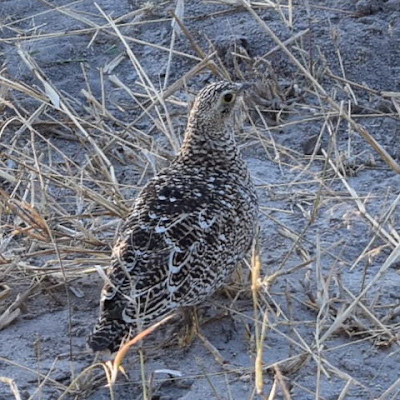 |
| Helen Mulligan |
Sunday August 20 Went for a walk at Clapp's Pond in Provincetown this afternoon. Ate huckleberries and blackberries growing at the side of the path. Picked bolete mushrooms for later consumption. An eastern swallowtail butterfly flitted about, circling us as we stopped to admire it.
Monday August 21 Had a spectacular afternoon watching humpback whales. As the boat approached an active area, just past Race Point near Provincetown, we were delighted to see a few whales coming up, arcing their backs and diving down. But that was only the beginning. The naturalist pointed out groups of hundreds of shearwaters gathering where the whales were starting to form a bubble raft, a circle of bubbles that concentrates their food. After a minute or so, several whales rose to the surface together, in a ring around the outside of the bubble raft, mouths wide open, taking in huge mouthfuls of water, filtering it with their baleen to capture vast quantities of krill and small fish. And the whales just kept on doing it, forming the bubble rafts, lunging up, mouths open, then surfacing a few times before diving deep. After watching a few bubble raft sessions, one of the whales breached, right close to the boat, but all I saw was the great splash as it landed; I thought I'd really missed it. Susan saw the whole thing. But then, over the time we were out with the whales, eight whales breached, a couple next to each other, right after one another, so I got to see several breach. Amazing.
Towards the end of our time there, a calf was playing about, sometimes swimming on its back, hitting the water with its flippers, showing the white underside of its flippers, sometimes slapping the water with its tail.
Most of the birds gathering at the bubble rafts were great shearwaters and sooty shearwaters, with a few laughing gulls hanging around, too. Shearwaters get their name from their flight, often just a few feet above the water, and even dipping the tip of a wing into the water, leaving a long, thin groove in the surface. Sooty shearwaters are terrific fliers, able to cover 1000 miles in a day during migration in optimal conditions. That's further than I can drive in a day, much further. The naturalist also saw Manx shearwaters, but I didn't. They used to be seen only rarely around here, but are becoming more common; they were first observed nesting in Massachusetts in 1973.
Back at the condo, Susan saw monarchs in the garden - we've been seeing them regularly.
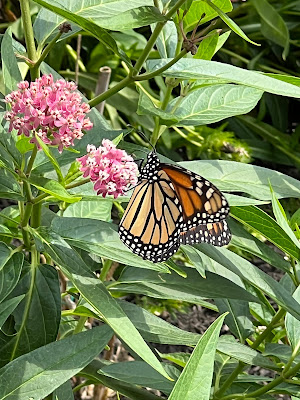 |
| Susan Brand |
Wednesday, August 23 Susan collected these black trumpet mushrooms on a walk with Ranger Nick this morning. All the rain we've had this summer has been good for mushrooms; she's found lots.
Friday August 25 Back in Boston, Beth and Dale pointed out these two juvenile mourning doves parked among the plants in their front yard. They recently left the nest and are still getting fed by their parents who keep depleting the feeder. I was amused by the description of their nests in Cornell's All About Birds: "A flimsy assembly of pine needles, twigs, and grass stems, unlined and
with little insulation for the young. Over 2 to 4 days, the male carries
twigs to the female, passing them to her while standing on her back;
the female weaves them into a nest about 8 inches across". Not sure how standing on the female's back helps the process...
Sunday August 27 I like the shiny purple leaves of this beefsteak plant that has escaped my neighbor's yard. It's a relative of mint and attracts butterflies.
Monday August 28 Starting to see more signs of fall. For the last couple of weeks, acorns falling from oaks. Yesterday, a horse chestnut on the ground at the Eliot School. And this morning, golden leaves on a small branch of a Japanese linden. When I looked at the tag, I noticed that it was propagated from a tree collected by Charles Sprague Sargent, the first Director of the Arb, in 1892.


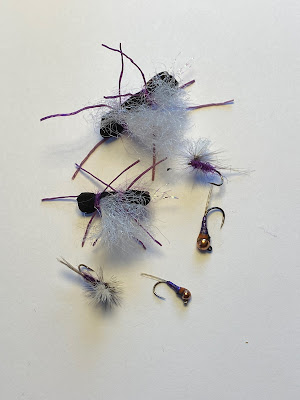





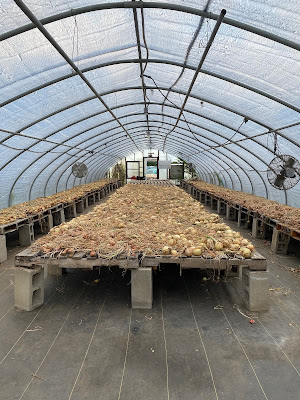
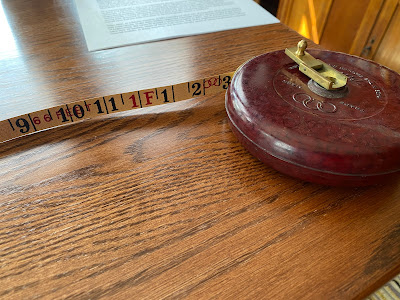

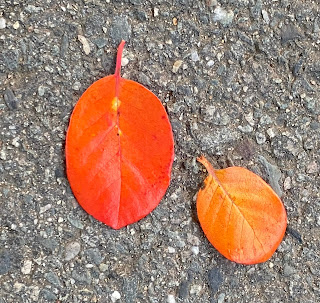








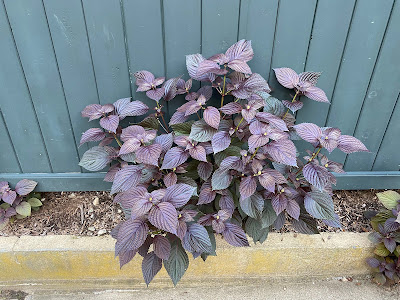




Comments
Post a Comment